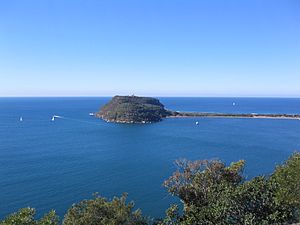Barrenjoey, New South Wales facts for kids
Barrenjoey is a unique piece of land found at the northernmost point of Pittwater, within the suburb of Palm Beach. This headland is mostly made of strong sandstone rocks. About 10,000 years ago, Barrenjoey was actually an island because sea levels rose. But over time, sand built up and created a natural bridge, called a tombolo, connecting the island back to the mainland. This makes Barrenjoey a "tied island". It is also home to the famous Barrenjoey Head Lighthouse, which first shone its light in 1881. In 1995, Barrenjoey became part of the beautiful Ku-ring-gai Chase National Park.
Contents
History of Barrenjoey
How Barrenjoey Got Its Name
On March 2, 1788, Captain Arthur Phillip, who was the first governor of New South Wales, named this headland "Barrenjuee." This name is thought to mean "little kangaroo" or "wallaby." Over many years, the spelling of the name changed a few times. The name "Barrenjoey" has been the official and accepted spelling since 1966.
Barrenjoey in Pop Culture
Since the 1980s, Barrenjoey has been a very famous location in the popular Australian soap opera Home and Away. You can often see it in the show's opening credits and in many scenes throughout the series.
Special Plant Life at Barrenjoey
Unique Ecosystems
Barrenjoey Headland is home to several special plant communities, which are groups of plants that grow together in certain conditions. In 2013, experts from the NSW Office of Environment and Heritage studied the area. They found small patches of a very rare type of forest called Coastal escarpment littoral rainforest. This is a subgroup of the Littoral Rainforest community, which is an endangered ecological community. This means it is very important to protect these plants because they are at risk of disappearing.
Other Plant Communities
Other interesting plant groups found at Barrenjoey include:
- Coastal Headland Clay Heath: These plants grow on the exposed parts of the headland.
- Coastal Sand Tea-tree-Banksia Scrub: You can find these plants on the sandy areas near the coast.
- Central Coast Escarpment Moist Forest: This forest grows in damper areas on the slopes.
- Coastal Sandstone Foreshores Forest: These trees grow on sandstone soils, especially where they are exposed to salty winds from the ocean.
Images for kids




